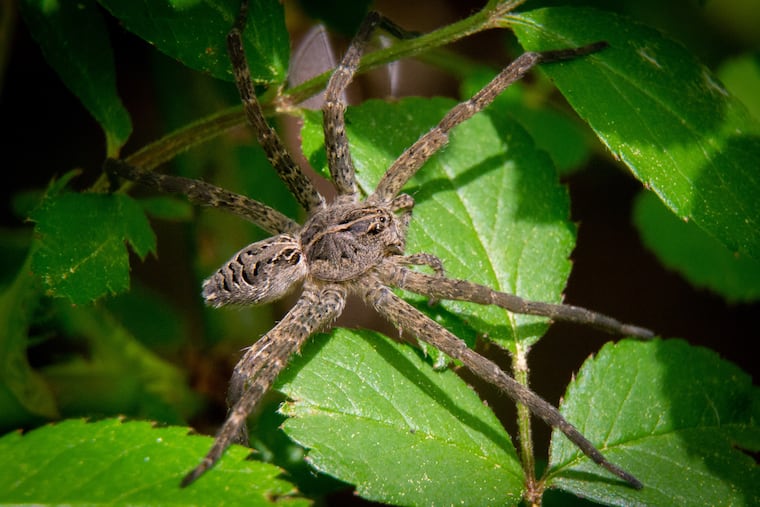Photos of an Australian spider eating a possum went viral. In Philly, spiders can also eat more than their weight.
No need to travel to Australia or the Amazon to see a giant spider eating something five times its own size—some of these impressive hunters are locals. Visit Roxborough-Manayunk and you might just see a fishing spider earning its namesake.

Spiders around the world have been making a splash with their frightfully huge meals.
In Australia, a huntsman spider dined on a small possum, and, as reported Wednesday by the Washington Post, the photo went viral. Earlier this year, a tarantula in the Amazon earned its own internet fame with a video showing the spider dragging away its meal — an opossum.
But there’s no need to travel to Australia or the Amazon to see a giant spider eating something many times its size. Visit Wissahickon Valley Park in Roxborough and Manayunk this summer, and you might just see a fishing spider earning its namesake.
Imagine diving underwater and hauling out an 800-pound bluefin tuna — in the middle of the night, and without any rod or net. While impossible for humans, fishing spiders, or Dolomedes, can catch fish up to five times their own weight, according to a 1989 study. And they are doing so right here in Philly.
According to the citizen science identification app iNaturalist, six species of Dolomedes live in the region, with three in Philadelphia near Wissahickon Creek. The largest is the Banded Fishing Spider, D. vittatus, which often grows to a leg span of over three inches.
“It can be really shocking to think that these are invertebrates that eat vertebrates," said Isa Betancourt, curatorial assistant of entomology at the Academy of Natural Sciences of Drexel University. She suggests that our fear might come from something we are not used to — feeling more like the prey than the predator: “We humans can relate to other mammals [and] to fish better. We see their eyes."
But Betancourt was emphatic that city residents are safe from these spiders.
“They’re not dangerous. They are scared; they know you are larger than them," she said. “The only situation where they’d bite you would be if you closed your hand around them.”
Connor Stout, an animal caretaker at the Philadelphia Insectarium and Butterfly Pavilion, agreed: “They will not chase after you. ... [They] are not a threat, just another part of our natural ecosystem.”
Even if a bite were to happen, Betancourt said, it wouldn’t require a visit to a doctor, except in rare cases people can be allergic to the bite, as with bee stings. She noted that the only spider in our region that would prompt a doctor’s visit is the black widow.
Betancourt hopes that people can appreciate that these spiders are “something to be in awe about.”
Fishing spiders hunt at night, and, unlike many spiders, make their impressive catches without the aid of a web.
“They’ve traded [their web] for the water’s surface,” she said. “They feel vibrations on the surface with the hairs on their legs. That’s their sight.”
These spiders can even walk atop the water, or dive under to avoid predators.
Intrepid Philadelphians looking to observe a fishing spider will need to head outside. “You’ll find them in reeds and small lakeside plants — frequently in parks, but not in areas where people live," said Stout. So far, there are only 20 photos of Philly’s fishing spiders on iNaturalist, and no one has been able to capture them with a fish “in fang.”
Despite our differences, Betancourt thinks that we can connect with these spiders over our shared hobby. “Anyone who enjoys fishing can see a fishing spider and see a fellow fisherman — a fellow species that enjoys the calm tranquillity of sitting, waiting for your catch,” she said.